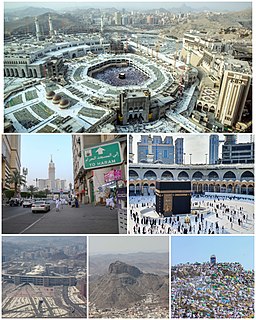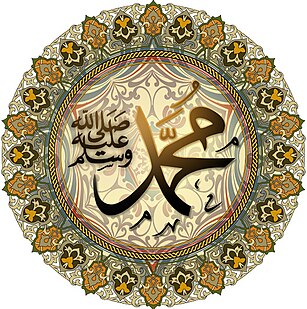
Mecca, officially Makkah al-Mukarramah and commonly shortened to Makkah is a city and administrative center of the Mecca Province of Saudi Arabia, and the holiest city in Islam. It is 70 km (43 mi) inland from Jeddah on the Red Sea, in a narrow valley 277 m (909 ft) above sea level. Its last recorded population was 1,578,722 in 2015. Its estimated metro population in 2020 is 2.042 million, making it the third-most populated city in Saudi Arabia after Riyadh and Jeddah. Pilgrims more than triple this number every year during the Ḥajj pilgrimage, observed in the twelfth Hijri month of Dhūl-Ḥijjah.

The Treaty of Hudaybiyyah was an event that took place during the time of the Islamic prophet Muhammad. It was a pivotal treaty between Muhammad, representing the state of Medina, and the Qurayshi tribe of Mecca in January 628. It helped to decrease tension between the two cities, affirmed peace for a period of 10 years, and authorised Muhammad's followers to return the following year in a peaceful pilgrimage, later known as The First Pilgrimage.

The military career of Muhammad, the Islamic prophet, encompasses several expeditions and battles throughout the Hejaz region in the western Arabian Peninsula which took place in the final ten years of his life, from 622 to 632. His primary campaign was against his own tribe in Mecca, the Quraysh. Muhammad proclaimed prophethood around 610 and later migrated to Medina after being persecuted by the Quraysh in 622. After several battles against the Quraysh, Muhammad conquered Mecca in 629, ending his campaign against the tribe.

Al-Fath is the 48th chapter (surah) of the Qur'an with 29 verses (ayat). The surah was revealed in Madinah in the sixth year of the Hijrah, on the occasion of the Treaty of Hudaybiyyah between the Muslim city-state of Madinah and Makkan polytheists. It mentions this victory, then criticizes the attitudes of the hypocrites, continues with further promises to the Muslims, and ends by mentioning certain important virtues of the Muslim community.

The ʿUmrah is an Islamic pilgrimage to Mecca that can be undertaken at any time of the year, in contrast to the Ḥajj, which has specific dates according to the Islamic lunar calendar.

Dhu al-Qa'dah, also spelled Dhu al-Qi'dah or Zu al-Qa'dah, is the eleventh month in the Islamic calendar.

The Conquest of Mecca was the capture of the town of Mecca by Muslims led by the Islamic prophet Muhammad in December 629 or January 630 AD (Julian), 10–20 Ramadan, 8 AH. The conquest marked the end of the wars between the followers of Muhammad and the Quraysh tribe.

Suhayl ibn ʿAmr, also known as Abū Yazīd, was a contemporary of the Islamic prophet Muhammad, and a prominent leader among the Quraysh of Mecca. Clever and articulate, he was known as the Khatib or orator of the tribe, and his opinion carried great weight among them.

Muḥammad ibn ʿAbd Allāh ibn ʿAbd al-Muṭṭalib ibn Hāshim, is believed to be the seal of the messengers and prophets of God in all the main branches of Islam. Muslims believe that the Quran, the central religious text of Islam, was revealed to Muhammad by God, and that Muhammad was sent to restore Islam, which they believe did not originate with Muhammad but is the true unaltered original monotheistic faith of Adam, Abraham, Moses, Jesus, and other prophets. The religious, social, and political tenets that Muhammad established with the Quran became the foundation of Islam and the Muslim world.

The Farewell Pilgrimage refers to the one Hajj pilgrimage that Muhammad performed in the Islamic year 10 AH, following the Conquest of Mecca. Muslims believe that verse 22:27 of the Quran brought about the intent to perform Hajj in Muhammad that year. When Muhammad announced this intent, approximately 100,000 of his Sahaba gathered in Medina to perform the annual pilgrimage with him. Muhammad performed Hajj al-Qiran.

The Islamic prophet Muhammad came to the city of Medina following the migration of his followers in what is known as the Hijrah in 622. He had been invited to Medina by city leaders to adjudicate disputes between clans from which the city suffered. He left Medina to return to and conquer Mecca in December 629.

Muhammad led the Conquest of Mecca in Ramadan of the Islamic year 8 AH. The Quraysh in Mecca was Muhammad's final major rival in the Arabian Peninsula, and following the conquest, Muhammad focused his military operations on further expansion of his Islamic realm to the north, with a campaign against the Ghassanids and the Byzantine Empire.

In the early days of Islam at Mecca, the new Muslims were often subjected to abuse and persecution. The persecution lasted for twelve years beginning from the advent of Islam to Hijrah. Muhammad preached Islam secretly for three years. Then, he openly preached Islam, resulting in public prosecutions. Muhammad and his followers were first belittled and ridiculed, then persecuted and physically attacked for departing from traditional Mecca's tribal ways.

The diplomatic career of Muhammad encompasses Muhammad's leadership over the growing Muslim community (Ummah) in early Arabia and his correspondences with the rulers of other nations in and around Arabia. This period was marked by the change from the customs of the period of Jahiliyyah in pre-Islamic Arabia to an early Islamic system of governance, while also setting the defining principles of Islamic jurisprudence in accordance with Sharia law and an Islamic theocracy.

The Pledge of the Tree or Pledge of Satisfaction or Pledge of Ridwan was a pledge that was sworn to the Islamic prophet Muhammad by his Sahaba (companions) prior to the Treaty of Hudaybiyyah. The pledge, sworn under a tree, was to avenge the rumoured death of Uthman bin Affan.

The Kaaba, also spelled Ka'bah or Kabah, sometimes referred to as al-Kaʿbah al-Musharrafah, is a building at the center of Islam's most important mosque, the Masjid al-Haram in Mecca, Saudi Arabia. It is the most sacred site in Islam. It is considered by Muslims to be the Bayt Allah and is the qibla for Muslims around the world when performing salah.
The Expedition of Qatan, was the first Raid on the Banu Asad bin Khuzaymah tribe, which occurred directly after the Battle of Hamra al-Asad in the year 4 A.H of the Islamic calendar.
The Patrol of Dhu Al-Ushairah occurred in the year 2 A.H. of the Islamic calendar between the months of Jumādi al-Ūlā and Jumādi al-Ākhirah .This was the 6th caravan expedition and the 3rd ‘Ghazwah’ occurring about 2 months after the Invasion of Buwāṭ.

Masjid al-Haram, also known as the Great Mosque of Mecca, is a mosque that surrounds the Kaaba in Mecca, in the Mecca Province of Saudi Arabia. It is a site of pilgrimage in the Hajj, which every Muslim must do at least once in their lives if able, and is also the main phase for the ʿUmrah, the lesser pilgrimage that can be undertaken any time of the year. The rites of both pilgrimages include circumambulating the Kaaba within the mosque. The Great Mosque includes other important significant sites, including the Black Stone, the Zamzam Well, Maqam Ibrahim, and the hills of Safa and Marwa.

The Muslim–Quraysh War was the six-year-long military and religious conflict in the Arabian Peninsula between the early Muslims led by Muhammad, and the Arab pagan Quraysh tribe. The conflict started in March 623 with the Battle of Badr, and concluded with the fall of the Quraysh tribe and the Conquest of Mecca.













